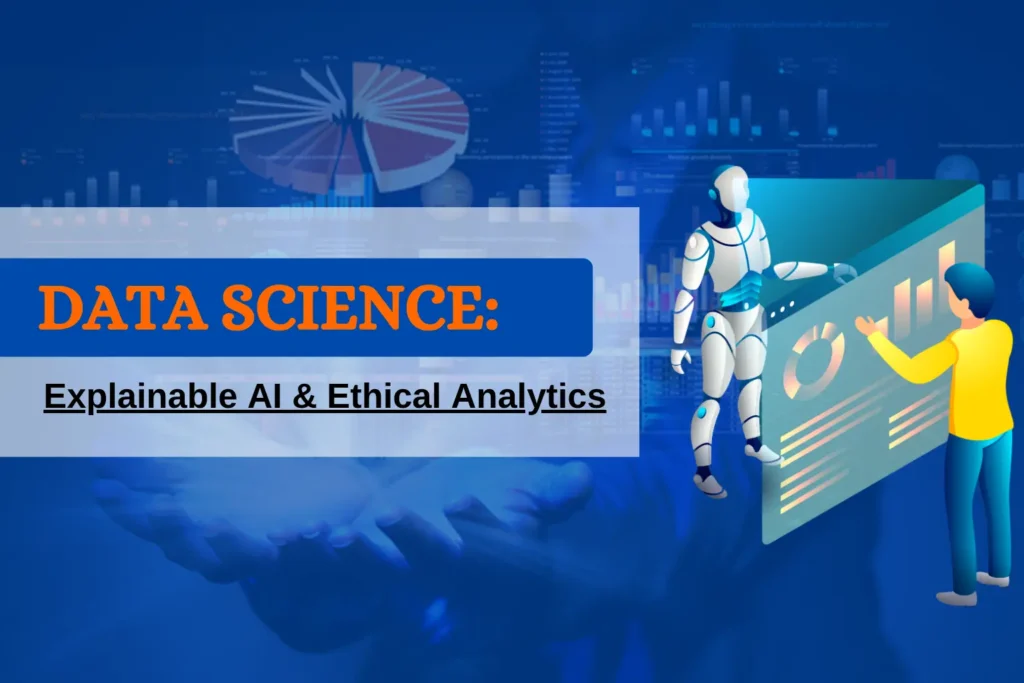
Introduction
In recent years, the fields of data science and artificial intelligence (AI) have experienced exponential growth, transforming industries and redefining possibilities. However, the increasing complexity and opaque nature of AI systems have raised critical concerns about accountability, transparency, and fairness. This is where Explainable AI (XAI) and Ethical Analytics come into play, aiming to revolutionize data science by fostering trust and aligning technology with human values.
The Need for Explainable AI
Bridging the Trust Gap
AI models, especially deep learning systems, are often considered “black boxes” due to their intricate and non-transparent decision-making processes. This lack of interpretability creates a trust deficit, particularly in high-stakes domains like healthcare, finance, and law enforcement. Explainable AI seeks to address this issue by making AI models comprehensible to humans without sacrificing performance.
Enhancing Accountability
Explainability ensures that stakeholders can understand, trust, and validate AI-driven decisions. For instance, in a scenario where a loan application is rejected, XAI can provide insights into the factors influencing the decision, enabling applicants to contest or improve their profiles.
Core Principles of Explainable AI
Transparency: Models should provide clear reasoning for their predictions.
Interpretability: The reasoning should be understandable to a non-technical audience.
Actionability: Insights derived from XAI should guide users in decision-making.
Ethical Analytics: The Guiding Compass
Importance of Ethics in Data Science
Data science thrives on the availability and analysis of vast datasets. However, this power comes with the responsibility to ensure that analytics respect privacy, avoid biases, and promote fairness. Ethical analytics emphasize:
Data Privacy: Ensuring that personal information is protected.
Fairness: Eliminating biases in algorithms and datasets.
Transparency: Clearly communicating how data is used and analyzed.
Challenges in Implementing Ethical Analytics
Bias in Data: Historical biases can perpetuate systemic inequalities when integrated into AI models.
Regulatory Hurdles: Adhering to diverse global regulations like GDPR and CCPA can be challenging.
Conflict of Interest: Balancing commercial goals with ethical considerations often creates dilemmas.
Synergy Between Explainable AI and Ethical Analytics
Combining XAI with ethical analytics forms a powerful framework for responsible AI development. Explainable AI supports ethical practices by providing clarity about algorithmic decisions, ensuring accountability, and identifying biases that may compromise fairness. Conversely, ethical analytics prioritize transparency and fairness, which naturally align with the goals of XAI.
Real-World Applications
Healthcare
In healthcare, explainable AI is critical for diagnosing diseases, recommending treatments, and predicting patient outcomes. For example, an AI model diagnosing diabetes should provide insights into contributing factors such as lifestyle, genetics, or previous medical history. Ethical analytics ensure that the data used respects patient privacy and avoids discrimination based on race, gender, or socioeconomic status.
Finance
In the financial sector, AI-driven models are used for credit scoring, fraud detection, and investment strategies. XAI can demystify these models, making them more trustworthy and actionable for both institutions and consumers. Ethical analytics help identify and mitigate biases that could unfairly disadvantage certain demographics.
Law Enforcement
AI is increasingly used in predictive policing and criminal risk assessment. Explainable AI can clarify how risk scores are determined, enabling law enforcement agencies to act transparently. Ethical analytics ensure these tools do not reinforce existing biases or infringe on civil liberties.
Key Tools and Techniques
SHAP (Shapley Additive Explanations): Provides a consistent way to explain individual predictions.
LIME (Local Interpretable Model-Agnostic Explanations): Explains predictions by approximating complex models with interpretable ones locally.
Fairness Indicators: Tools for assessing and mitigating bias in datasets and models.
Privacy-Preserving Techniques: Such as differential privacy and federated learning, to ensure data confidentiality.
Emerging Trends
Regulatory Push
Governments and organizations worldwide are introducing regulations to ensure ethical AI usage. For instance, the European Union’s AI Act emphasizes transparency and risk management.
Integration of Ethics in AI Education
Institutions are embedding ethics and explainability into AI and data science curricula to prepare future professionals for responsible AI development.
Human-Centered AI Design
A shift toward designing AI systems that prioritize human values, emphasizing inclusivity, empathy, and accessibility.
Challenges and Future Directions
Balancing Performance and Explainability
Highly explainable models sometimes sacrifice performance, creating trade-offs that need careful consideration.
Addressing Diverse Stakeholder Needs
Different users—from technical experts to laypersons—require varying levels of explanation, necessitating flexible XAI frameworks.
Keeping Pace with Technological Advancements
As AI evolves, ensuring that explainability and ethics keep pace with new methodologies and use cases is critical.
Conclusion
Explainable AI and Ethical Analytics are not just optional features but necessities in today’s AI-driven world. They empower stakeholders, build trust, and ensure that technology serves humanity responsibly. By embracing these principles, we can reinvent data science as a discipline rooted in transparency, fairness, and accountability, paving the way for a future where AI is not only powerful but also ethical and comprehensible
You may explore quality training on AI and Machine Learning with us.
Know More: https://mindforgeinfotech.com/
